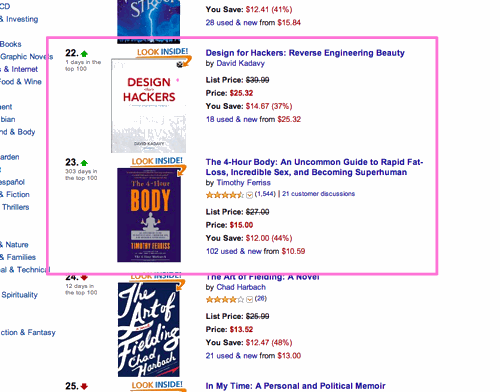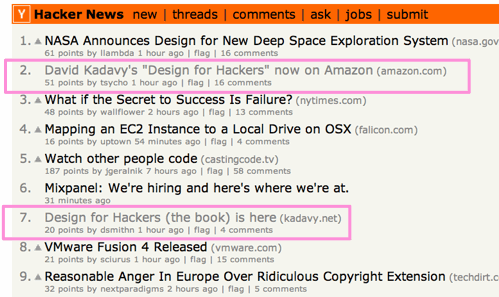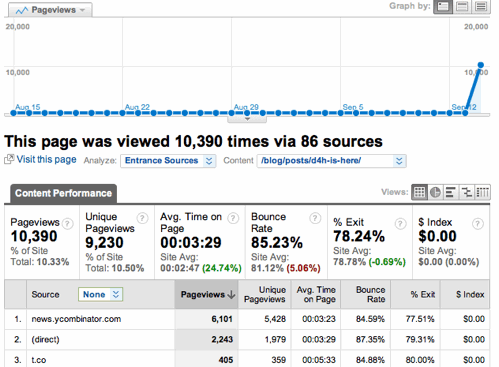Subscribe to blog updates via email »
Zero to Best-Seller in 4 Hours
7:35 this morning I was awoken by a call from my Publisher, Chris Webb from Wiley. I wasn’t expecting to hear these words any time soon in my life:
Best-selling author, David Kadavy!
I was aware that yesterday Design for Hackers ranked as highly as #18 overall on Amazon, but I hadn’t really been called this before – especially not from one of the world’s largest publishers. This was for real.

WANT TO WRITE A BOOK?
Download your FREE copy of How to Write a Book »
(for a limited time)
Even Chris was surprised to be saying this. Weeks earlier, as I prepared for the launch, I asked him what was the ultimate, maximum thing I could possibly expect to achieve with this book.
“Usually, we try to go for top 100 on the Computers & Internet category.”
When I asked, timidly, whether I should go for NYTimes best-seller status, he said it was “not possible.”
Just a “Technology Book”
As I understand it, the reason was that Design for Hackers is what is referred to as a “technology book,” in the publishing industry. Everything about these books is designed to get them out quickly enough that they aren’t out-of-date by the time they are released. The timeline is breakneck fast (I had 6 months to write – long by “technology book” standards), and (maybe because of this?) the price tends to be much higher (around $40 cover price) than your typical paperback (around $15). Plus, the audience is much, much smaller.
Somehow, on launch day, my book easily burned through #1 in the Computers & Internet category, all of the way to #18 overall on Amazon (currently #32). Author Central says there are over 8,000,000 books being sold on Amazon. #18. Wow.
Design for Hackers blew past many mainstream titles: Go the F**ck to Sleep, Dick Cheney’s In My Time, and even past Tim Ferriss’s The 4-Hour Body. (It’s only sort of coincidental that “4 Hours” is part of the title of this post. I really admire, and have learned a lot, from Tim’s work. This book couldn’t have happened without many things I learned from The 4-Hour Work Week)

This despite nearly everything that usually comes along with a mainstream book release. I can hardly count the number of things that weren’t exactly how it “should” be done about this launch:
- The release came earlier than I had expected, so I didn’t have time for the standard “pre-order push.” This helps determine how many books are printed and shipped, and helps with NYTimes best-seller status, so it was purportedly not that critical.
- Probably somewhat due to the above, Amazon ran completely out-of-stock within about an hour. It currently says it “Usually ships within 7 to 13 days.” Who buys a book that is that back-ordered!? Apparently, you do, and I thank you for that. (my publisher has informed me that they are working with Amazon on getting the book back in stock)
- There were ZERO reviews on the Amazon page. The book timeline has been fast, and this book is a pretty in-depth read, so there wasn’t time to get genuine reviews up. (There is currently a review up from an early reader)
- Most physical bookstores don’t have the book on their shelves. Not that there are many left. But, the other day I wanted to drop by my local Barnes & Noble to sign some books, only to find out they still weren’t in stock.
Not to mention that I have no publicist, no literary agent, and no staff.
So, how did this happen?
I’m not going to pretend this is a complete mystery just for the sake of appeal. I worked with what experience, resources, and relationships I had to do the best launch I could. I, of course, want this book to do very, very well. I talked with friends like Noah Kagan (AppSumo), and Ramit Sethi (NYTimes best-selling author of I Will Teach You to be Rich) to see what advice they had. I made sure to keep an email list, and cherish its subscribers, and to try to coordinate a launch in which I get lots of people to all buy my book at once.
There are a few things that I can posit (besides a hunger for design literacy) contributed to such an amazingly successful launch: my email list, Hacker News, and Kickstarter.
The email list
This group of folks has by far had the most impact (though most of them come from Hacker News, which I’ll talk about next). I’ve built it up since I announced the book deal. I tried to give them content as it came along, though honestly, I didn’t get as much out as I had planned because the book-writing was just too intense. I’ve had plenty of unsubscribes, but many have stuck with me along the way. I’ve gotten to know many of them, gotten their feedback and support, and learned a lot about what they need to learn about design.
So, after posting on my blog, I emailed these amazing people and explained to them my situation: my book is out > I want it to do well on Amazon > please buy it.
Hacker News
Incredibly, there were not one, but two links related to Design for Hackers on the front page of Hacker News all day yesterday: the blog post (which wasn’t a gigantic surprise), but even the Amazon link (which was a huge surprise). The blog post alone got over 10,000 views yesterday. 10,000 views on a post that basically says “hey, here’s my book, please buy it?”


Since the Amazon link actually performed better on Hacker News (and is now on the Amazon best-seller list), I can only imagine it got much more traffic.
Kickstarter
A couple of weeks ago, I also had a successful Kickstarter campaign. Part of the reason I couldn’t coordinate a “pre-launch” was because it took nearly a month just to get my campaign accepted to Kickstarter. It got rejected twice, but I kept working on it. Honestly, it turned out much better because of it.
The Kickstarter campaign had a number of benefits. I also suspect it may have had the killer benefit:
- I got to practice launching. I don’t have a ton of experience launching things (other than blog posts). It was good practice in trying to convey what I had to offer strongly enough that 138 people – many whom I didn’t know before – took out their wallets and gave me money to tour the U.S..
- It built awareness. I was amazed at how much people rallied around the Kickstarter campaign. I’m sure many people who hadn’t heard of my book before did because of it’s success.
- It built my confidence. When you spend most of your day behind a computer, in your apartment by yourself, you sometimes have no idea if anyone really cares about what you’re producing. It’s always nice to have positive feedback and be reassured that there will be some people who are interested in what you’re offering.
And the killer benefit?
I ordered the books for Kickstarter backers, in succession, on Amazon yesterday. It may surprise you that it was actually much easier (and just as cost-effective) to just send the books to my Kickstarter backers through my Amazon Prime account. Yup, I paid Amazon’s full price for each of them. One side-benefit was Kickstarter uses Amazon Payments, so I got to use my balance from that to buy the books (so, I didn’t have to pay Amazon Payments fees on that portion). I knew I was going to be busy with the launch, so I hired a contractor to do the ordering for me.
Not a ton of orders. “Only” 70 books. They were doing it so fast that Amazon’s fraud department called to make sure the activity was authorized. “Are you buying things today?” “Yes, I most certainly am.”
So, while my blog post was going viral, and many of you were kindly buying my books, my Kickstarter backers were also having their books ordered for them. This may have helped with the ranking.
I say may because Amazon’s rankings are a big mystery. The only thing I really know about them is that they are updated very rapidly – probably by the hour.
I was told through a couple of sources that if I ordered all of the books from the same account that the orders wouldn’t affect my ranking. Other sources said that it might. I suppose that it probably did.
That’s It?
Of course, these things didn’t materialize out of thin air. This is just what I did to make the best of what I had at hand. I still like to think that people have enjoyed my writing thus far around the Design for Hackers topic, and that they are generally amazingly hungry to learn more about design. It’s still incredible to me that something as seemingly mundane as fonts and colors is of such interest to so many people.
How far can this go?
In my conversation with my publisher this morning, he conceded that now, yes, it may be possible to reach the NYTimes best-seller list. Even with the lack of reviews, and out-of-stock woes, this little “technology book” could hit the mainstream. Could you imagine that?
Imagine a discussion on NPR about the hidden meanings of different fonts.
Imagine Conan O’Brien talking about design literacy.
Imagine Oprah talking about white space. (even if she hadn’t retired, this, admittedly, would be unlikely, but you get the idea.)
Furthermore, imagine the mainstream media using the word “hacker” for what it really means: someone with a thirst for solving problems, a passion for sharing, and a vision to reinvent his or her world.
Maybe I’m just dreaming, but you’ve already exceeded my dreams. So, thank you for that.




